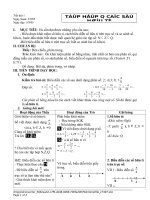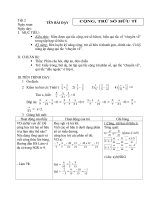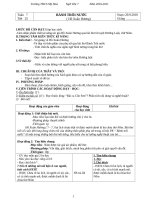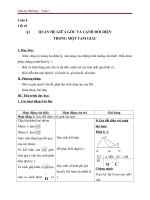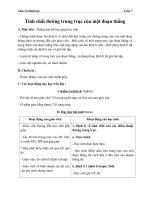Lecture 06 7 sed n met rx k
Bạn đang xem bản rút gọn của tài liệu. Xem và tải ngay bản đầy đủ của tài liệu tại đây (5.13 MB, 51 trang )
Lecture 6-7
Sedimentary and Metamorphic Rocks
Part 1
Sedimentary Rocks
Kyanite, Sillimanite, and Andalucite
What is a sedimentary rock?
• Sedimentary rocks result from mechanical
and chemical weathering
• Comprise ~ 5% of Earth’s upper crust
• About 75% of rocks at surface
• Contain evidence of past environments
• Record how sediment is transported
• Often contain fossils
What is the economic importance of
sedimentary rocks?
• They are important for economic reasons
because they contain
• Coal
• Petroleum and natural gas
• Iron, aluminum, uranium and manganese
• Geologists use them to read Earth’s history
Cementation
• Precipitation of chemicals dissolved in water
binds grains of a sediment together.
• After the cements solidify, compaction drives
out the excess water.
• Important part of Lithification
• Remember where cements come from?
Types of sedimentary rocks
• Chemical rocks – sediment from
ions that were once in solution
• Detrital rocks –sediment
transported as solid particles
Detrital sedimentary rocks
• Constituents of detrital rocks can
include
• Clay minerals
• Quartz
• Feldspars
• Micas
• Particle size is used to distinguish
among the various types of detrital
rocks
Detrital sedimentary rocks
• Mudrocks: less than .063 mm
– 1. Mud: small particles easily kept in
suspension
– Settles in quiet water
– Includes Shale: mud-sized particles <.004
mm deposited in thin bedding layers
called laminae
Most common sedimentary rock
2. Larger mudrock grains called silts
silt-sized particles .004-.063 mm
Gritty grains can be felt
Detrital sedimentary rocks
• Sandstone
– Made of sand-sized particles larger
than .063 mm and less than 2mm
– Forms in a variety of environments
– Sorting, angularity and composition
of grains can be used to interpret the
rock’s history
– Quartz is the predominant mineral
(due to its durable nature)
Detrital
sedimentary
rocks
• Conglomerate and breccia
– Both composed of particles > 2mm in
diameter
– Conglomerate consists largely of rounded
clasts. Rounded pebbles in high velocity areas
– Breccia is composed of large angular
particles Breccia is made of shattered rock that accumulates at the base of a cliff
Energy
• Coarse sediments are deposited in high
energy (fast water) environments such as
under breaking waves at the beach, or in
the beds of fast streams.
• Fine sediments are deposited in low
energy environments, e.g. the slow water
of deep lagoons, the abyssal plain, etc.
Chemical sedimentary rocks
• Precipitated material once in solution
• Precipitation of material occurs two
ways:
• Inorganic processes: the minerals
precipitate out of water
• Organic processes: animals and plants
precipitate the minerals to use as shells
or skeletons
/>
• Common chemical sedimentary rocks
•Limestone
–Most abundant chemical rock
–Made of the mineral calcite CaCO3
–Marine biochemical limestones form
as coral reefs, coquina (broken
shells), and chalk (microscopic
organisms)
–Inorganic limestones include
travertine (caves) and oolitic
limestone (Bahamas)
/>
• Common chemical sedimentary
rocks
•Evaporites
–Evaporation triggers
deposition of chemical
precipitates
–Examples include rock salt
and rock gypsum
Chemical Sediments: Coal
Sedimentary environment determines roundness sorting, mineral diversity
Character of detrital sediments depends on time,
6_5
distance, and
energy. For example, in streams:
Particles are large and
irregular, and consist of
a variety of lithologies,
including the least
resistant.
Particles are mid-sized
and of intermediate
sphericity, and include
resistant and nonresistant
lithologies.
HIGHLANDS
LOWLANDS
Particles are small and
nearly spherical, and
consist mainly of the
most resistant lithologies,
such as quartz.
NEAR-COASTAL
Graded bedding
Floods change the local
conditions
6_6
Fine-grained sediment
On floodplain
Older sediment
1
Pre-flood
Bounders on
bottom, sands and
muds suspended
Flood water
Erosion of uppermost
fine-grained sediment
2
Flood stage
Waning flow
Fine-grained above
Coarse-grained
below
Bedding plane
3
Post-flood
• Sedimentary Facies
• Different sediments accumulate
next to each other at same time
• Each unit (called a facies) possesses
a distinctive characteristics
reflecting the conditions in a
particular environment
• The merging of adjacent facies
tends to be a gradual transition
Some Facies in an oversimplified drawing
Abyssal Ooze
Stillwater muds
Nearshore sands
Strata- Bedding Planes
Slabs of eroding sandstone with ripple marks
Cross Beds are ripples in cross section
• Irregularities lead to ripples, dunes,
sand bars.
• In cross section these look like lines
at an angle to the horizontal – “cross
beds”
• Ripples can indicate direction of air or
water flow if asymmetrical, a tidal
environment if symmetrical. Size and
shape indicate fluid velocity.
Cross bedding in Sand Dune deposits
Navaho Sandstone
Sandstone deposited
in ancient sand dunes
Frosted Grains, well sorted
Mud Cracks: clay layer shrinks during drying, curls
upward; cracks fill next flood. Useful for right-side up
Terms for Marine (i.e. Ocean) Environments
6_27
and some characteristic
sediment facies
Continental
shelf
Shallo
w
marin
e
Abyssal
Plain
Dee
p
Define Graded Beds
Continental
slope
mar
ine
Submarine
volcanoes
Fossils are traces of prehistoric life generally
preserved in sedimentary rock
